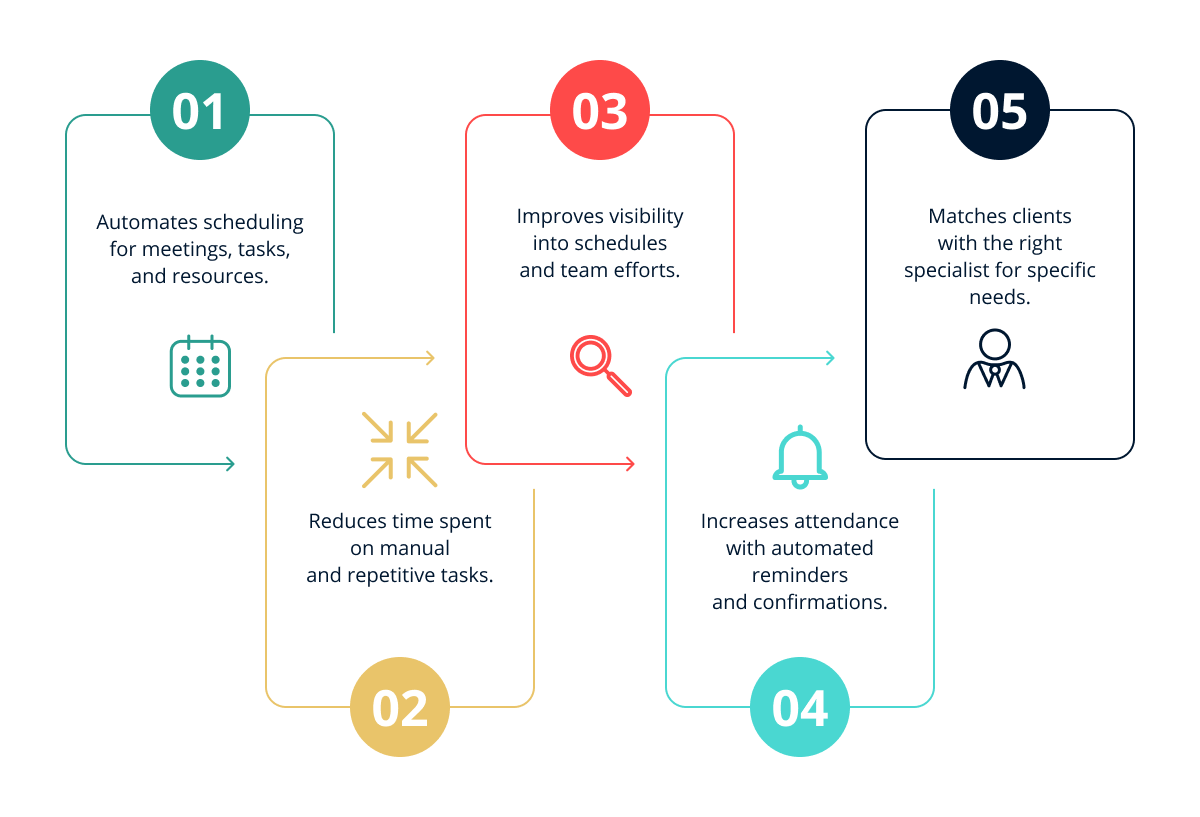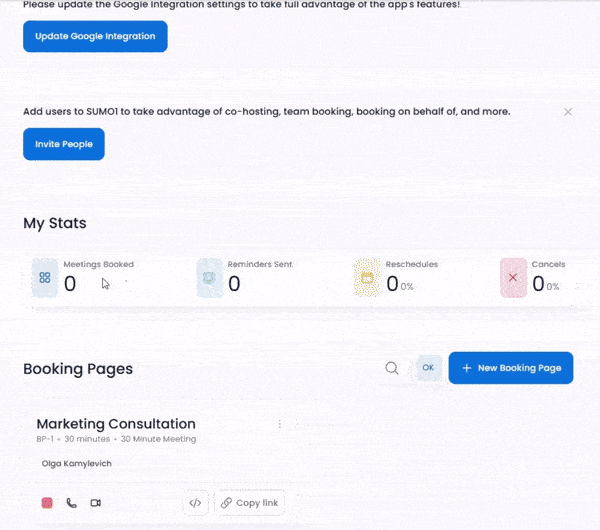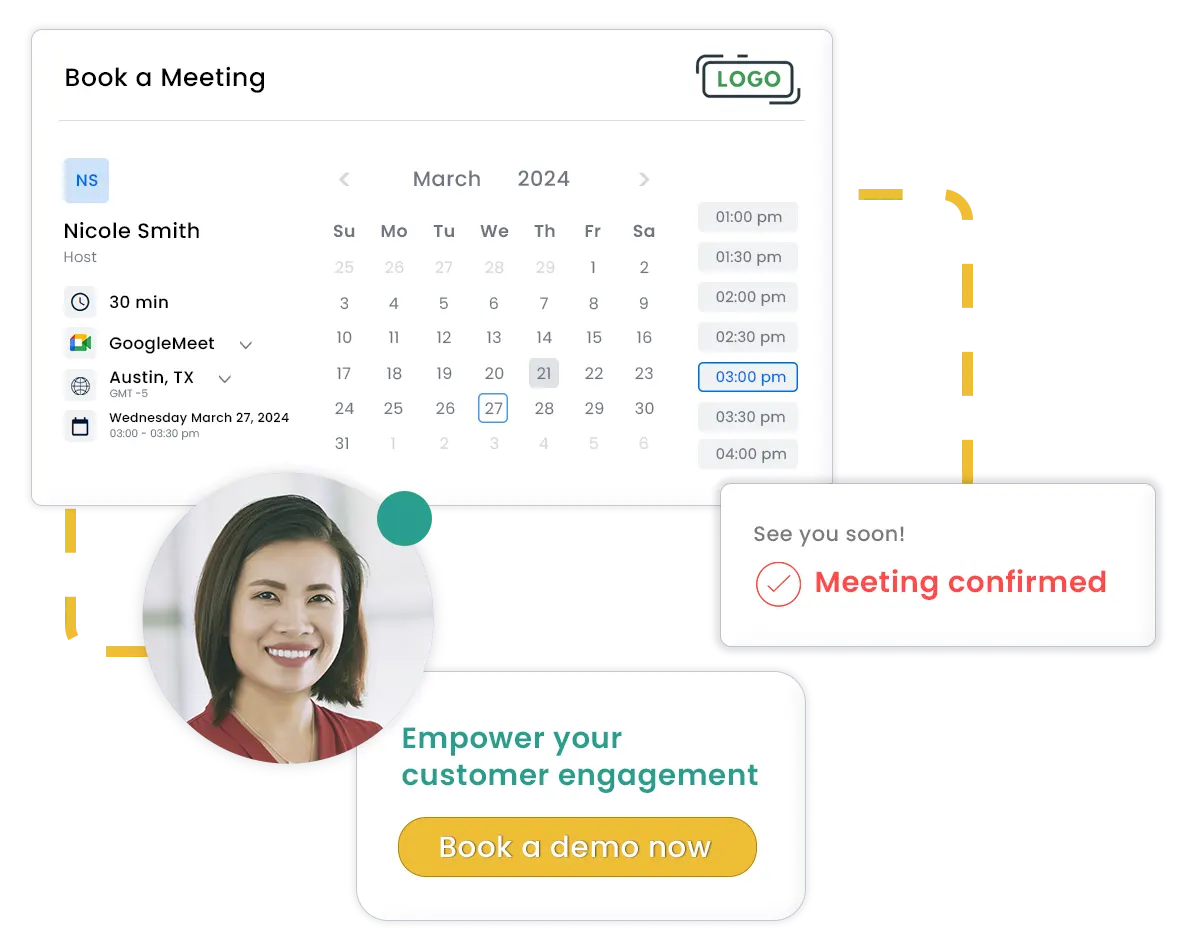Few businesses can do without meetings (or e-meetings). In customer-facing orgs, they are the most crucial part that drives the revenue engine forward. But scheduling those meetings? That’s often a hidden bottleneck.
While your team spends hours playing calendar Tetris and chasing down no-shows, your business loses opportunities. Luckily, AI fixes that.
In this post, you’ll learn how AI appointment scheduling works and why it’s a big step up from basic booking tools. We’ll show you how businesses are using AI schedulers to engage with customers faster, save team productivity time, and bring in more revenue without adding more work.
Key Takeaways
- AI schedulers like SUMO Scheduler go beyond simply showing open time slots. They act as full customer engagement systems, allowing you not only to streamline meeting bookings but also to automate prep, meeting notes, CRM updates, and follow-ups—creating better customer interactions at every stage.
- This impacts your business on every level — your team saves hours each week, your customers get a faster, smoother experience, and you close more deals with less manual work.
- Businesses using AI schedulers see 70% more bookings, 2× conversions, and shorter sales cycles—all thanks to 24/7 availability, smart routing, real-time calendar sync, automated reminders, and follow-ups.
- Sales, service, and support teams in healthcare, service, finance, wellness, real estate, and retail are rapidly adopting AI scheduling, as inefficient booking directly affects their daily revenue. They also see the impact of AI almost immediately.
Why Scheduling Is Still a Bottleneck for Enterprises and SMBs
Even with all the scheduling tools out there, you might still find your team spending way too much time juggling calendars, emailing back and forth to confirm times, rescheduling no-shows, and dealing with last-minute changes.
If you’re at an enterprise, the challenge only grows. Your scheduling workflows are tired to multiple departments, time zones, skill sets, and priorities. Most basic tools just can’t keep up, which means you’re left fixing double bookings or handling missed appointments.
And if you’re running a small or mid-sized business, every hour counts. When your team is stuck doing manual scheduling, that’s time taken away from helping customers or closing deals.
Additionally, slow response times can cost sales opportunities, especially for customer-facing teams. A 5-minute delay in responding to an online lead can drop your conversion by 80%. Yes, there are chatbots which solve the instant-reply dilemma but… 50% of customers find them frustrating.
As a matter of fact, the problem with online scheduling isn’t just inefficiency. It’s revenue loss.
How inefficient scheduling hurts your business
- Missed calls and limited booking hours mean missed sales opportunities.
- Appointment booking friction creates a poor customer experience, meaning lower engagement with your brand.
- Admin tasks eat up team productivity time and lower their motivation.
So let’s take a closer look at where traditional scheduling tools fall short, and where AI starts to make a real difference.
Where Basic Scheduling Tools Fall Short and AI Schedulers Win
AI can handle complex scheduling logic
Simple scheduling tools can’t manage complex appointment logic — for example, routing meetings based on skill, team, location, or urgency — which is vital for organizations in healthcare, education, public service, and retail.
In fact, it’s vital for any distributed business operating in multiple locations or one with complex infrastructure.
Real-time availability requires real-time tools
Basic scheduling apps can’t manage staff availability based on real-time changes. Any last-minute cancellations or reschedules just result in lost time. This time can be regained by notifying other customers about earlier openings.
Booking alone isn’t enough — CRM sync matters
Next, having a meeting booked is one piece of the puzzle. Syncing all data live with the CRM is another — and that’s where most appointment apps fail.
Customers book across channels
Multi-channel booking is another sore spot. Your clients want a frictionless experience no matter the channel. While traditional scheduling apps perform on just a few, AI schedulers embed smoothly on any — website, chatbot, mobile app, email, or social media.
Customers and teams expect speed and convenience, so businesses need a smarter way to handle booking — and that’s exactly where AI appointment scheduling helps.
What Is AI Appointment Scheduling (and What It’s Not)

AI appointment scheduling uses artificial intelligence to create an autonomous process of booking, rescheduling, and managing your appointments, making it a win-win for both your business and customer.
It isn’t just an online calendar you share with a customer or a booking link that shows open slots. Rather, it’s a smart system that curates your entire scheduling workflow — from initial request to follow-up — without human effort.
It blends a stack of technologies like machine learning, smart routing, and conversational AI to:
- Capture the user intent to meet (e.g., “I need to meet with a support manager next week”)
- Coordinates timezones and locations
- Find the right person or team based on rules, roles, or availability
- Scan your teams’ real-time availability and offer the best time slots
- Automate reminders, reschedules, and post-meeting follow-up
- Handle reschedules and cancellations with minimal impact to productivity
Basic scheduling tools like Calendly or email plugins still require you to make all the decisions based on each meeting. Read between the lines: you still spend a lot of time on managing your calendars.
AI scheduling works more like a smart assistant or agent. It asks questions, leads the conversation (always patient and polite), guides the customer, and makes decisions for you. You set your availability once, and keep the process running smoothly all the time.
AI scheduling doesn’t mean only scheduling. It extends to what happens during and after appointments, standing as an intelligent routing, decision-making, and follow-up assistant. ”
For example, SUMO Scheduler provides AI appointment scheduling as part of its Customer Engagement Platform, which lets your reps not just books meetings but also prepare agendas, capture and log meeting notes, and helps your team to follow up with personalized emails based on the conversation. You cut the manual work before and after the meeting, not just during the scheduling.
See how SUMO Scheduler boost productivity and improve every customer interaction
The Real Impact of AI-Powered Scheduling on Your Business
Manual scheduling and meeting coordination may seem like small tasks — but they add up fast and quietly eat into your team’s time, focus, and customer experience.
Time-draining tasks you can hand off to AI — per meeting
| Task | Time Saved Per Meeting |
| Scheduling & coordination | 15 min |
| Pre-call planning | 30 min |
| Live note taking & CRM updates | 30 min |
| Writing & sending follow-ups | 20 min |
| Total per meeting | ~1.5 hours |
With just 15 meetings per week, that’s 22.5 hours/week or ~90 hours/month per rep spent on manual work — nearly 56% of a full-time month.
Now consider this.
One AI engagement platform like SUMO Scheduler automates every stage of the meeting process. You not only eliminate the scheduling bottleneck but also build smarter customer engagement journeys—saving your team over 50% of a full-time month on admin and low-value tasks like meeting prep, note capture, and post-call follow-ups.
What happens when you switch to SUMO’s AI
+70% Increase in Appointment Bookings
With self-service AI scheduling, clients book faster, without friction — anytime, anywhere.
2× Higher Conversion Rates
Less drop-off. More qualified meetings. Automated reminders and routing to the right person boost results.
7 Days Shorter Sales Cycles
When AI takes over coordination and follow-ups, deals move faster.
Better Meeting Show-ups & Satisfaction
AI helps clients get the right time with the right person — increasing reliability and trust.
Manual Appointment Tasks AI Automates
Let’s break it down. Here’s what AI scheduling systems can automate:
1. Meeting Booking and Routing
- Match the customer to the right team based on geography, availability, or priority
- Offer real-time time slots that match everyone’s calendar
- Prevent double-booking
2. Reminders and Rescheduling
- Automatically send reminders to reduce no-shows
- Offer reschedule links if a time no longer works
- Detect when someone cancels and fill the slot
3. Meeting Preparation
- Pull data from CRM to prep the team
- Suggest agenda items or customer notes
- Add meeting context for better outcomes
4. Call notes and summaries
- Transcribe calls and log to CRM
- Generate meeting summaries
- Capture action items or blockers
5. Post-Meeting Follow-up
- Log notes directly into CRM
- Trigger follow-up actions
- Send recap emails or next-step forms
By handling these repetitive tasks, AI frees up hours each week for teams to focus on their real job: helping customers and closing deals.
How AI Appointment Scheduling Systems Work

At its core, AI appointment scheduling works as a digital brain. It constantly tracks your team’s calendars for any moving slots and matches them with customer preferences to pinpoint the ideal time for every single engagement.
Here’s what happens behind the scenes:
1. User Request Comes In
In terms of user experience, it can be an AI chatbot that understands the meeting intent as the customer chats, e.g., “I need to talk to someone about my account” or “Book a demo for next Tuesday.” Or it might be a self-service online booking system embedded into your website, social network, email, or text message.
Once the user engages with online booking, AI starts to perform its magic.
2. AI Identifies the Right Team or Person
The system applies logic to route the appointment. If you run a small business, you likely need just a simple time-availability match — and AI can perfectly handle it.
If you’re in an enterprise and your teams operate in multiple locations and departments, AI helps you assess the meeting context and capture essential data to route the request correctly:
- Who handles this type of request?
- Is it sales, support, or onboarding?
- What time zone and location is the customer in?
- Is this a new or returning customer?
And you can rest assured that the system pulls this context from CRM data, customer profiles, or predefined business rules, so no double bookings occur. In a Salesforce-native tool like SUMO Scheduler, this routing uses live Salesforce data (roles, ownership, case type, etc.).
3. Calendar Matching in Real Time
Next, the system scans your calendars to match the request with the rules. Depending on your business and use case, you can apply:
- Working hours
- Meeting buffers
- Time zones
- Location
- Priority levels (e.g., VIP routing)
- Rotation rules
- Other preferences you need
4. Smart Suggestions and Booking
Once AI finds the right options, it suggests them to customers for confirmation (if it’s an AI website chat) or instantly books a slot. The entire process takes seconds — and that’s the beauty of AI.
Another advantage: you don’t have to worry about rescheduling and reminders. AI never forgets them and always includes a timely follow-up with links to reschedule or cancel, syncing all changes in real time.
5. Meeting Prep and Follow-Up
Once the meeting is live on both calendars, you or your reps just need to check what’s on agenda. AI helps with prep too — just ask for a brief, and AI pulls data not just from your CRM (which many schedulers can do), but also from public data sources like company or lead information, making ice-breakers easier than ever.
During a meeting, it can help you automatically:
- Log your meeting notes
- Trigger follow-up asks
- Send recap emails
- Update your CRM records just by asking AI
This end-to-end flow makes AI scheduling more than just a calendar tool. It acts like a virtual coordinator that’s ready to assist 24/7.
Where AI Appointment Scheduling Makes the Biggest Impact
AI appointment scheduling is vital for teams that regularly meet with clients, customers, or patients. These include sales reps—online and in the field, service teams—again, online or in the physical world (like retail), and support teams. For any of these audiences, an AI scheduling system stands as an invaluable time and effort saver.
Here’re some real-world examples of businesses who’ve implemented it and are gaining benefits.
Healthcare
AI medical appointment scheduling helps patients book visits online, receive automated reminders, and reschedule if needed — without ever calling the front desk.
Example:
A plastic surgery clinic moved to SUMO’s AI patient scheduler as they were losing over $10,000 a month due to outdated, manual processes that overwhelmed staff and blocked new appointment requests. They automated booking across multiple channels, reduced no-shows, and gave clients an easier way to self-schedule — freeing up staff to focus on service.
Salons, Spas & Fitness Centers
AI-powered chatbots integrated with social DMs and websites can manage salon & spa appointment scheduling in a humal-like conversation.
Customers don’t need to browse calendars, they can just ask about the time to meet and AI suggests best-fit options. Moreover, AI can handle recurring sessions, waitlists, and class limits automatically. It sends instant confirmation and even reschedules or cancels through a simple link — all without calling the front desk.
Example:
BraidsLab introduced an AI appointment scheduling system to connect customers with trusted stylists across the U.S. Instead of calling or texting to find someone, clients just enter what they need — like the occasion or hairstyle — and BraidsLab’s AI shows nearby braiders, their prices, and open time slots. Clients can book right away, and the system takes care of the rest: confirming the appointment, sending reminders, and managing requests for at-home visits.
Wellness Centers
Whether it’s acupuncture, nutrition, or holistic care, clients want convenience. AI scheduling for wellness centers gives them 24/7 access to book services and automatically sends reminders and intake forms.
Example:
Umbo, an Australian healthcare provider focused on speech and occupational therapy for children, implemented SUMO’s AI Scheduler to automate therapist matching in real time. This reduced scheduling time by 90%, saving practice managers 7 hours per week. The time and cost savings have helped Umbo boost profits and reinvest more into expanding care for disadvantaged children.
Retail
Retailers often juggle back-to-back meetings. AI scheduling in retail eliminates the friction of coordinating with clients across locations, time zones, keeping the calendar full and organized.
Real Estate
In real estate, speed matters. Prospective buyers and renters want to schedule viewings quickly. AI enables them to book instantly and receive real-time updates or confirmations — even after hours.
Financial & Legal Services
From mortgage advisors to wealth managers, clients appreciate easy access to professionals. AI scheduling for financial services lets them pick a time, receive helpful reminders, and stay on track with financial planning.
Final Thoughts
If your team meets with customers, patients, or clients regularly, scheduling isn’t just a background task — it’s part of the experience you deliver. And when scheduling is slow, manual, or disorganized, it hurts your bottom line and your customer relationships.
AI-powered scheduling is a clear way to save your time, reduce missed appointments, and give your customers an easier way to connect with your business.
And with SUMO Scheduler, you get more than just a calendar tool. You get a smart AI assistant that helps you book faster, prep better, follow up on time, and keep everything in sync with your CRM.




